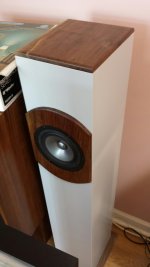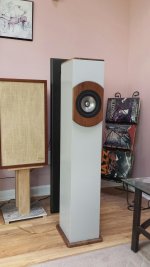Now I should have pointed out that you can trade width of the cabinet for depth of the enclosure if you are concerned about internal reflections. I modeled internal dimensions of 6" width x 7.5" depth or a cross-sectional area (CSA) of 45 sq. in. You could just as well select a 7.5" width and a 6" depth and have the same internal CSA.
With this in mind, could you also build a square speaker box as long as the CSA remained at 45 sq in.? ie. internal measurements of 6.7" x 6.7" (or 170mm x 170mm).
Last edited:
As mentioned in another current thread - unless sealed, the overall shape - i.e. the third dimension of an enclosure -and location of driver / ports can be very significant.
You'll probably note that many of the popular designs discussed have aspect ratios to their CSA that are not square.
You'll probably note that many of the popular designs discussed have aspect ratios to their CSA that are not square.
I had noticed that, so if the design has a specific aspect ratio that should be left as is, however the orientation of that aspect ratio isn't important. So a 5x7 design can be a 7x5, but not a 6x6. Is that right?
As long as you maintain the CSA you can vary the depth or width dimensions for this design. Now you do have specific limits--baffle width is a function of the outside diameter of the driver or the internal clearance for the driver--and such to consider.
Hence, a square internal CSA (6.7 x 6.7 inches) would be OK.
Hence, a square internal CSA (6.7 x 6.7 inches) would be OK.
Last edited:
Cheers Jim. Confusion reigns! Why does this particular design not require a certain aspect ratio when others do?
Tyler, I did not specify the aspect ratio in this design. I wanted to give the builder latitude to build per his needs/desires. Given the size of the driver, you have some ability to make your own choice of baffle width vs. cabinet width.
A specified baffle width would have locked down the cabinet depth. But some people like the looks of a wide cabinet and would trade width for depth while others prefer a squarer look.
Thanks for your interest in this design.
Jim
A specified baffle width would have locked down the cabinet depth. But some people like the looks of a wide cabinet and would trade width for depth while others prefer a squarer look.
Thanks for your interest in this design.
Jim
Thanks for the info it's just ChrisB suggests that the aspect ratio can have an impact on the sound.
My design is a MLTL per Martin King's spread sheets. It uses the T/S parameters of the MA Alpair 10.3 and the simulation iterates the position of the driver and port within the enclosure to optimize the bass frequency response.
Thus, while a MLTL may appear to be just an ordinary vented design, the location of the driver and port, the length between the two, the port diameter, cross-section of the box and the stuffing are design elements which enhance the bass.
Thus, while a MLTL may appear to be just an ordinary vented design, the location of the driver and port, the length between the two, the port diameter, cross-section of the box and the stuffing are design elements which enhance the bass.
Help!
My mltl 10.3 are now well broken in, I assume, but they seem to have developed a harshness when playing complex passages. The bass performance is superior for a driver this size and single acoustic instruments, small combo jazz, for example are great.
But on more than one occasion I find I have to turn the volume down due to being quite irritating, edgy, harsh.
My long term reference for all my speaker building adventures has been my Apogee Centaurs, bought in 1991 and known for their silky smoothness and overstuffed bass(less) performance.
Now, I don't expect any speaker that I build to be the equal of the Centaur, pro or con, but I do like them to be highly musical and listenable, and I have achieved these goals with most of my builds, but not these mltl, yet.
Andrew bee, or anyone else have experience, pro or con with this driver or this cabinet?
Comments will be most welcome.
Peter
My mltl 10.3 are now well broken in, I assume, but they seem to have developed a harshness when playing complex passages. The bass performance is superior for a driver this size and single acoustic instruments, small combo jazz, for example are great.
But on more than one occasion I find I have to turn the volume down due to being quite irritating, edgy, harsh.
My long term reference for all my speaker building adventures has been my Apogee Centaurs, bought in 1991 and known for their silky smoothness and overstuffed bass(less) performance.
Now, I don't expect any speaker that I build to be the equal of the Centaur, pro or con, but I do like them to be highly musical and listenable, and I have achieved these goals with most of my builds, but not these mltl, yet.
Andrew bee, or anyone else have experience, pro or con with this driver or this cabinet?
Comments will be most welcome.
Peter
Attachments
Help!
My mltl 10.3 are now well broken in, I assume, but they seem to have developed a harshness when playing complex passages. The bass performance is superior for a driver this size and single acoustic instruments, small combo jazz, for example are great.
But on more than one occasion I find I have to turn the volume down due to being quite irritating, edgy, harsh.
My long term reference for all my speaker building adventures has been my Apogee Centaurs, bought in 1991 and known for their silky smoothness and overstuffed bass(less) performance.
Now, I don't expect any speaker that I build to be the equal of the Centaur, pro or con, but I do like them to be highly musical and listenable, and I have achieved these goals with most of my builds, but not these mltl, yet.
Andrew bee, or anyone else have experience, pro or con with this driver or this cabinet?
Comments will be most welcome.
Peter
My mltl 10.3 are now well broken in, I assume, but they seem to have developed a harshness when playing complex passages. The bass performance is superior for a driver this size and single acoustic instruments, small combo jazz, for example are great.
But on more than one occasion I find I have to turn the volume down due to being quite irritating, edgy, harsh.
My long term reference for all my speaker building adventures has been my Apogee Centaurs, bought in 1991 and known for their silky smoothness and overstuffed bass(less) performance.
Now, I don't expect any speaker that I build to be the equal of the Centaur, pro or con, but I do like them to be highly musical and listenable, and I have achieved these goals with most of my builds, but not these mltl, yet.
Andrew bee, or anyone else have experience, pro or con with this driver or this cabinet?
Comments will be most welcome.
Peter

Sorry, I have not completed my pair yet.
The cabinets are built, internal damping sheets applied, just not finished and have been in the same state for maybe 6 months (or more). Stuffing is weighed out. Mahogany veneer and contact cement present and accounted for, its just me. I seem to have lost my speaker mojo at the moment.
I have been doing little audio related things of late unfortunately.
My excuse is I have returned to my baking which seems to be more popular with the family.
Everything is cyclic so I am sure I will get back to the MLTL's in due course and in the meantime I continue to listen to my Cambridge Audio R50's.
Andrewbee
Peter - please forgive the sloth evidenced by my question, but what type of amp are you using with the A10.3s?
Hi Chris....
At the moment I am using an Onkyo 9010 integrated that I picked up fairly recently for the remote convenience features. It drives my Centaurs and Finalists beautifully. In fact, I'd say the Apogees have never sounded better.
Source is either Onkyo 7555 Cdp or Lp12 with Naim 322( modded)phono pre.
I also have B4 preamp(piglets dad) and Symasym 5.3 amp that haven't been fired up lately while I evaluate the Onkyo.
Peter
At the moment I am using an Onkyo 9010 integrated that I picked up fairly recently for the remote convenience features. It drives my Centaurs and Finalists beautifully. In fact, I'd say the Apogees have never sounded better.
Source is either Onkyo 7555 Cdp or Lp12 with Naim 322( modded)phono pre.
I also have B4 preamp(piglets dad) and Symasym 5.3 amp that haven't been fired up lately while I evaluate the Onkyo.
Peter
Follow up
Well, I have added another 100 hours or so of realistic listening level to the speakers and the harshness seems to be mitigating. I also found that, whereas previously I had the speakers positioned into the room about 3 ft from the front wall, I tried different locations and found that about 4 to 6" from the wall gives a much better balance. My mltl are rear ported.
My other speakers include Finalists and Apogee Centaurs, both of which require a good distance behind them to sound remotely acceptable, in my room.
Thanks again, Jim.
Peter
Well, I have added another 100 hours or so of realistic listening level to the speakers and the harshness seems to be mitigating. I also found that, whereas previously I had the speakers positioned into the room about 3 ft from the front wall, I tried different locations and found that about 4 to 6" from the wall gives a much better balance. My mltl are rear ported.
My other speakers include Finalists and Apogee Centaurs, both of which require a good distance behind them to sound remotely acceptable, in my room.
Thanks again, Jim.
Peter
I recently purchased a vintage Onkyo TX-4500mkll receiver and the 10.3 mltls have been transformed. Attributable, I assume the warmth of the phono section/amplifier. No hint of harshness or fatigue. What a difference an amp makes.
- Home
- Loudspeakers
- Full Range
- Mark Audio Alpair 10.3/A10p MLTL

